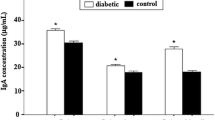Abstract
Saliva was investigated for its suitability as a biopsy tissue for the determination of glucose-6-phosphate dehydrogenase deficiency. It appears that there is a significant difference between the activity of the enzyme in patients and controls. However, some controls have very low values making discrimination between patients and controls using a qualitative method impossible.
Glucose-6-phosphate dehydrogenase deficiency is a relevant clinical problem in many rural areas in developing countries. Existing methods for determination of the deficiency in blood and hair follicles do not meet the criteria necessary for their large scale introduction in the areas of the world that are concerned by the problem. The present study shows that saliva is not a suitable alternative.
Between the three biopsy tissues compared: blood, hair follicles and saliva, hair follicles remain most attractive since their isolation hardly involves the risk of infection. A simplified method for the detection of glucose-6-phosphate dehydrogenase activity in hair follicles that would allow health service workers in the field to determine the carrier status of pregnant women might form the basis for a future kernicterus prevention programme.
Similar content being viewed by others
References
BeutlerE (1959) The hemolytic effect of primaquine an related compounds: A review. Blood 14: 103–139
CarsonPE, FlanaganCL, IckesCE & AlvingAS (1956) Enzymtic deficiency in primaquine-sensitive erythrocytes. Science 124: 484–485
DoxiadisSA, FessasPh & ValaesT (1961) Glucose-6-phosphate dehydrogenase deficiency. A new aetiological factor of severe neonatal jaundice. Lancet i: 297–301.
GeerdinkRA, HorstR & StaalGEJ (1973) An Iraqi Jewish family with a new red cell glucose-6-phosphate dehydrogenase variant (Gd-Bagdad) and kernicterus. Irs. J. Med. Sci. 9: 1040–1043
KayLA (1987) HIV transmitted by kissing (letter). Brit. Med. J. (Clin. Res.), 294: 706
LowryOH, RosebroughNJ, FarrAL & RandallRJ (1951) Protein measurement with the Folin reagent. J. Biol. Chem. 193: 265–275
LuzzattoL, UsangaEA & ReddyS (1969) Glucose-6-phosphate dehydrogenase deficient red cells: resistance to infection by malarial parasites. Science 164: 839–842
MiguelA, RamonM, PepitpierreE, GoosCMAA, Vermeesch-MarkslagAMG & VermorkenAJM (1983) Population screening for glucose-6-phosphate dehydrogenase deficiency on the Baleares. Hum. Genet. 64: 176–179
MoncktonCh (1987) HIV transmitted by kissing (letter). Brit. Med. J. (Clin. Res.) 294: 706
PanizonF (1960) Erythrocyte enzyme deficiency in unexplained kernicterus. Lancet ii: 1093
RamotB, ShebaC, AdamA & AshkenasiJ (1960) Erythrocyte glucose-6-phosphate dehydrogenase deficient subjects: enzyme-level in saliva. Nature 185: 931
SealhJ (1987) HIV transmitted by kissing (letter). Brit. Med. J. (Clin. Res.) 294: 705–706
SmithGD & VellaF (1960) Erythrocyte enzyme deficiency in unexplained kernicterus. Lancet i: 1133–1134
VermorkenAJM, WirtzP, SpierenburgGTh, vanBennekomCA, deBruynCHMM & OeiTL (1979) Glucose-6-phosphate dehydrogenase deficiency: biochemical and histochemical studies on hair roots for carrier detection. J. Clin. Chem. Clin. Biochem. 17: 325–329
VermorkenAJM, MarkslagAMG, GoosCMAA, MiguelA, RamonM & PetitpierreE (1982) Human hair follicles may be used for population screening of heterozygotes of glucose-6-phosphate dehydrogenase deficiency. Clin. Genet. 22: 57–61
WeatherallDJ (1960) Enzyme deficiency in haemolytic disease of the newborn. Lancet i: 835–837
WHO (1967) Standardization of procedures for the study of glucose-6-phosphate dehydrogenase. Report of a WHO scientific group. Technical Report Series, No. 366
WongHock Boon, WeePeng Heng, TeoSiew Hong, KnooBin Choo & ChewSoh Eng (1978) Glucose-6-phosphate dehydrogenase screening utilising a commercial kit. J. Singapore paediat. Soc. 20: 81–86
ZinkhamWH, LenhardtREJr & ChildsB (1958) A deficiency of glucose-6-phosphate dehydrogenase activity in erythrocytes from patients with favism. Bull. Johns Hopkins Hosp. 102: 169–175
Author information
Authors and Affiliations
Rights and permissions
About this article
Cite this article
Beamont, A.H.G.M., Miguel, A., Goos, C.M.A.A. et al. The suitability of saliva for detection of glucose-6-phosphate dehydrogenase deficiency. Mol Biol Rep 13, 73–78 (1988). https://doi.org/10.1007/BF00539053
Received:
Accepted:
Issue Date:
DOI: https://doi.org/10.1007/BF00539053




